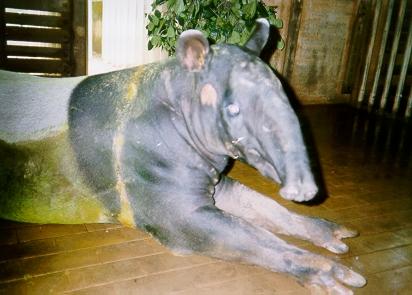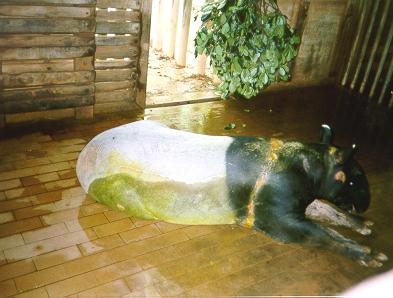

Both Sonny Wong and myself went down to Zoo Melaka, on the request of CEO, Dr. Low, to check on the well being of the animal. (Re: Press Release on the 29/6/99, 'Tapir should be released into the wild') After getting the permission from the Director of the zoo, En Nawayai, we went on the 6/7/99.
Upon reaching there we met up with Dr. Razeem, the veterinarian of the zoo. During our conversation, we came to know that he was our former MNS scientific and education officer. He took us to the quarantine area where the tapir was recovering. The room also housed an old cataract-eyed female rhino and another female tapir. At first glance the tapir seemed fine, lying on its side resting. Dr. Razim however pointed out that Adek was actually under a lot of pain and was given painkillers. The wounds and markings on her body caused a lot of pain and stress. The abrasions were the result of the ropes used to tie and lift her, presumably by the fishermen. Tapirís skin, according to Dr. Razim, is quite thick but the rope had cut right through and this caused severe superficial pain.

"Adek is seen here lying on its side and not able to move much
due to the pain."
We had a long chat with Dr. Razeem. According to him the animal had not been swimming in the sea voluntarily. According to some local fishermen, a boat ferrying animals illegally was seen in the area. The tapir most probably jumped out of the boat and ended up being spotted by local fishermen. According to him, tapirs were not observed to swim such a distance, as it would face severe dehydration due its high surface/mass ratio. The salinity of the waters will only cause it to loose water via osmosis. Only larger mammals, like the elephant, with a lower surface/mass ratio would be able to swim such a distance.

"The wounds on Adek as seen from behind. The door behind allows her
to go out freely."
Asked about the future of the tapir, he said that Adek would be left
to recover after which it would most probably be used for breeding. There
was also a possibility that she may be shipped out to another zoo overseas.
He said that there is not much space left in our forests for these animals
(territorial), even National Parks. These animals are not really rare,
their ratio is about 1 tapir to 10 pigs. With the constant threat of logging,
development and land clearing the chances are that more animals might just
be forced out of a home. He also stressed that his department only specializes
in the rescuing of animals and not capturing. Those animals that wander
into plantations or residential areas are not captured but are chased back
into the nearby forests. Only animals that are trapped or injured are rescued
and brought back to the zoo.
Other than matters concerning wildlife, Dr. Razeem requested the assistance of MNS members, especially those from the Negeri Sembilan/Melaka Branch, who were willing to lend a helping at the zoo. Members would be required to help nurse animal cubs as well as other ground duties. He was also interested in a tree-planting programme in the animal enclosures in which MNS could be involved. This is because many trees had been axed for the construction of a new safari.
The visit to the Melaka Zoo turned out more than a visit to Adek. It
could actually lead to many new ideas and programmes for MNS and definitely
a better understanding of the zoo itself.